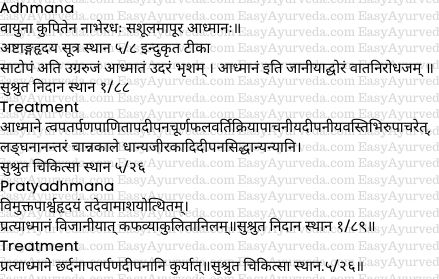Adhmana, Pratyadhmana Meaning, Symptoms, Treatment
By Dr Raghuram Y.S. MD (Ay) & Dr Manasa, B.A.M.S
Adhmana is a common term used in Ayurveda literature and often used to describe distension of the abdomen. It is induced by vata dosha. It is also a symptom of not only the abdominal disorders but also of many other systemic disorders explained in Ayurveda. Adhmana means swelling, inflation, puffing, intumescence or enlargement.
Table of Contents
Adhmana is a vata disorder
Adhmana has been included in the Vata Vyadhi Nidanam chapter of Madhava Nidana. It has been considered as a vata disorder and the pathogenesis of adhmana too explains the same. Master Sushruta too has included these conditions in the chapter named as vata vyadhi nidanam and has hence included them under the vata disorders.
Read – Different Causes For Vata Dosha Imbalance, Increase

Definition of Adhmana
Master Indu commenting on 8th verse of 5th chapter of Ashtanga Hrdaya Sutra Sthana defines Adhmana as – ‘The vata gets aggravated and causes pain below the navel. This condition is called Adhmana.’
Definition by Master Sushruta
Master Sushruta in the 88th verse of the first chapter of Sushruta Nidana Sthana defines Adhmana as below described –
‘Adhmana is a condition caused by forcibly controlling / obstructing the fart reflex. This eventually causes aggravation of vata. This aggravated vata causes distension abdomen along with severe pain and enormous sounds in the abdomen. The swelling of abdomen is in the form of an air filled bag or water filled pot’.
Here ‘udara’ indicates abdomen. But to be specific it has to be considered as a colon (Madhukosha commentary). Therefore adhmana begins and gets located in the colon / large intestine which is also the chief seat of vata and is caused by aggravated vata therein. In other words the obstruction of vata in the major parts of the intestines i.e. colon and small intestines other than the stomach and the mentioned symptoms manifested therein is called adhmana.
Read – Symptoms Of Vata Dosha Increase And Imbalance – Vata Vruddhi Lakshana
Pathogenesis
- Habit of forcibly withholding the urge of farting and excessive exposure to etiological factors cause aggravation of vata
- This aggravated vata gets accumulated and stagnant in the lower part of the abdomen below the navel
- Distension of abdomen is caused by the aggravated vata and the abdomen appears like air filled sac
- The distension of abdomen is associated with gurgling sounds in the abdomen and severe pain in the lower part of the abdomen (below navel)
Read – Do Not Suppress Body Urges: Charak Samhita Sutrasthana 7th chapter
Symptoms
- Distension of abdomen
- Severe pain in the lower part of the abdomen (below the navel)
- Gurgling sounds in the abdomen
Read – Kukshi Shula Causes, Symptoms, Pathogenesis, Treatment
Sanskrit Verses

Treatment
Nidana Parivarjana – Since withholding of natural urges, mainly that of fart and feces is the main causative factor for aggravation of vata and manifestation of adhmana one needs to keep away from these causes. One has to give way and help out the naturally impending reflexes / urges created by the body.
Principles of treatment
- Apatarpana – starvation / limited intake of food, fasting, lightening measures
- Pani tapa – giving warmth to the abdomen by hands (after rubbing the palms and generating heat or after warming the hands over mild fire)
- Dipana churna – herbal powder prepared with digestive fire kindling herbs
- Phalavarti – suppositories
- Pachana – ama digesting medicines
- Vasti – medicated enemas (decoctions and oil / ghee)
- After lightening measures, food prepared with digestive fire kindling herbs like coriander, cumin seeds etc is given for eating. This will be the ideal diet in adhmana.
- Vata balancing measures – Since adhmana is caused by aggravation of vata, vata balancing measures, therapies and lifestyle activities are adopted.
- Therapeutic purgation and enema are ideal choices to cleanse the gut, to throw out the impurities including fart, gases and faeces and to balance vata.
- Vatanulomana i.e. guiding the vata in downward direction using anti-vata medicines and foods.
- Herbal oil massage and fomentation over the lower abdominal area, and use of oral herbal vata-alleviating oils will also come in handy.
Other treatment principles
Adhmana shall be treated on the lines of treatment principles of the below mentioned conditions –
- Anaha – flatulence disorder
- Udavarta – pathological upward movement of vata, mainly udavarta caused due to habit of forcibly withholding the fart reflex
- Shula – abdominal colic
- Gulma – abdominal tumour
- Vataja Udara – abdominal disorder caused by vitiated vata
Read – Charaka Udara Roga Chikitsa – 13th Chapter
Formulations
- Gandharvahastadi Kashayam
- Vayu Gulika
- Dhanwantaram Gulika
- Hingvashtaka Churna
- Bhaskara Lavana Churna
- Narayana Churna
- Hingutriguna Taila
- Gandharvahstadi Eranda Taila
Formulation From Sahasra Yoga Text Book
Kumaryasava
Difference from Atopa and Anaha
Atopa is a condition in which aggravated vata causes gurgling sounds in the abdomen but there is no constipation. Anaha is a condition wherein there is distension of the abdomen caused by obstruction of faeces and urine. Adhmana is a condition wherein abdominal distension is caused by obstructed gases and presents along with pain and gurgling sounds.
Read – Basti Shula (Shoola) Meaning, Symptoms, Causes, Pathogenesis, Treatment
Pratyadhmana
Pratyadhmana is yet another condition explained in the vata disorders, in the context of adhmana. Adhmana manifesting with similar signs and symptoms in the regions other than the flanks (abdominal sides) and chest (abdominal region very close to the heart) and manifested in the stomach is called pratyadmana. This condition is caused due to the kaphavrita vata i.e. aggravated kapha obstructing the vata in the stomach region. So adhmana manifests in the colon and intestines and a similar condition occurring in the stomach is called pratyadhmana.
Read – How To Balance Kapha Vata Dosha? 6 Factors To Consider
Treatment of Pratyadhmana
- Vamana – emesis
- Apatarpana – therapeutic starvation / fasting
- Dipana – digestive fire kindling medicines
Modern Correlation
Admana is correlated to a condition called ‘tympanitis or generalised tympanitis or meteorism’ explained in the modern texts. Pratyadhmana can be compared to ‘pyloric stenosis’ or ‘gastric tympanitis or cardalgia’.
Click to Consult Dr Raghuram Y.S. MD (Ayu)






